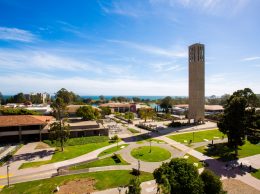With $2.3 million in recent federal funding, Sansum Diabetes Research Institute is moving forward with clinical trials of its artificial pancreas, a device that researchers hope will substantially improve the lives of people living with Type 1 diabetes.
In 1922, the institute’s founder, Dr. William Sansum, was the first physician to administer U.S.-made insulin to a diabetic patient. The event at the Potter Metabolic Clinic at Cottage Hospital in Santa Barbara came a few years after Dr. Frederick Banting and other researchers discovered that insulin could duplicate the pancreatic secretions that are missing or deficient in the metabolism of a person with diabetes.
Those breakthroughs showed that diabetes was “not a fatal disease, but a chronic condition that can be managed,” Dr. Alison Okada Wollitzer, the institute’s director of research administration and operations, said at a March 11 informational event.
Following those advancements, Sansum Diabetes Research Institute been at the forefront of diabetes, endocrinology and metabolic research. For the past four years, it has been working closely with researchers at UC Santa Barbara to develop an artificial pancreas that would serve as an all-in-one device to monitor glucose levels and dispense insulin as needed.
Clinical trials on the project began in 2011. The device has been developed and tested in the lab for the last three years and is now being tried out on people outside of the lab, institute officials said. That means researchers are following test subjects around in their daily life to see how the device deals with varying activity levels, meals, sleep and so forth.
Researchers hope to eventually produce a safe, cost-effective device that can be commercialized on a large scale.
Need for better technology
Since Dr. Sansum’s breakthrough 92 years ago, diabetes has become a more controllable condition with the advent of ever-smaller and more accurate insulin pumps and glucose monitors. But absent a cure, technology hasn’t yet reached its full potential to alleviate the suffering caused by the disease.
Sansum Diabetes Research Institute’s focus has been specifically on Type 1 diabetes — also known as juvenile diabetes — which can’t be controlled with diet and exercise alone. It’s an autoimmune disorder in which the patient’s body attacks cells that produce insulin, the hormone that helps the body turn food into energy.
There’s no cure, and the only treatment is relentless blood sugar monitoring coupled with careful diet control and insulin injections. Over the long term, high blood sugar puts Type 1 diabetics at risk of kidney disease, heart disease and blindness. But pumping in too much insulin can bring blood sugar down to dangerously low levels in the short term.
Devices that constantly monitor glucose levels already exist, as do pumps to administer insulin into the blood. But the connection between the two — how much insulin it takes to get blood sugar in a safe range — has mostly been a matter of keeping paper logs and simple calculation. Even with careful monitoring, many patients spend a lot of time outside the normal blood sugar range.
Wollitzer said it’s a common myth that a diabetic who wears an insulin pump “can just set it and forget it.” Glucose levels can be affected by a range of factors throughout the day including food, stress and sleep. In fact, the group said, every year more than 15 in every 100 people with Type 1 diabetes experience either a coma or seizure requiring hospitalization as a result of high or low blood sugar levels.
In October 2013, Sansum Diabetes Research Institute announced that it had received a three-year, $2.3 million federal grant from the U.S. Department of Health and Human Services, mostly targeted at Type 1 diabetes research and development of the artificial pancreas. Much of the project’s previous funding has come from the Juvenile Diabetes Research Foundation.
The artificial pancreas would work by gathering data from a continuous sensor attached to the body and using that information and a complex set of algorithms to tell the insulin pump what to do. Patients would be able to access their information through an easy-to-use app.
“Sansum Diabetes Research Institute has been making tremendous strides in reaching most of our goals in Type 1 diabetes research,” Dr. Howard Zisser, the study’s principal investigator, said in a statement in October. “However, there is much more we need to do to keep up the momentum for treating the disease, improving quality of life, reducing the impact of diabetes on our society, as well as building a bridge to a cure. [The artificial pancreas] is a quantum leap forward in this critical area of diabetes research.”






 Print
Print Email
Email
















